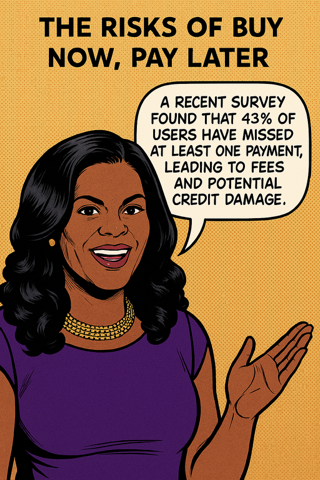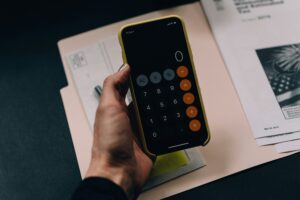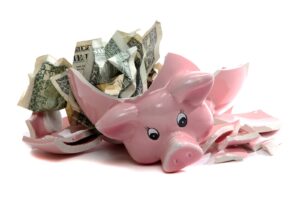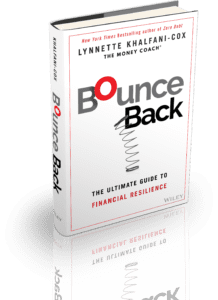Buy Now, Pay Later, or BNPL, is quickly becoming a huge form of debt for millions of Americans.
What is BNPL?
BNPL stands for “Buy Now, Pay Later,” a form of short-term financing that lets consumers split purchases into smaller, interest-free payments—typically over a few weeks or months. Companies like Klarna, Affirm, Afterpay, and Zip offer these services at checkout, giving shoppers the option to delay full payment without using a credit card.
I still remember the crushing weight of credit card debt. In my 30s, I was drowning in bills, watching the interest compound while the credit cards got maxed out. The stress was constant.
So when I see the explosion of “Buy Now, Pay Later” services, I understand the appeal—breaking payments into manageable chunks without the brutal interest rates of credit cards seems like a godsend.
But as a personal finance expert, I’ve watched with growing concern as BNPL has expanded from big-ticket purchases like furniture and electronics to… well, just about everything.
From Klarna and Affirm to Afterpay and Zip, these services are being integrated everywhere, letting consumers split payments for increasingly questionable purchases.
Here are 10 of the wildest things people are now buying with Buy Now, Pay Later services that make me wonder: have we gone too far?
1. Weight Loss Drugs
Yes, you read that correctly. Wegovy, the popular weight loss injection that costs around $1,300–$1,600 per month, can now be financed through BNPL services. While Novo Nordisk (the manufacturer) is exploring “Buy Now, Pay Later” options to make their treatments more accessible, I can’t help but worry about people financing medical treatments this way. When something impacts your health, should you really be stretching payments over time and potentially skipping doses if you miss a payment?
2. DoorDash Food Delivery
In what might be the most concerning development yet, DoorDash recently partnered with Klarna to offer BNPL options for takeout food delivery. GrubHub offers BNPL too.
Let that sink in—people are now financing burritos and pizza in four easy payments. When you’re putting your Chipotle order on an installment plan, it might be time to reevaluate your finances.
3. High-End Makeup
The beauty industry has embraced BNPL in a major way. Through Klarna, shoppers can buy luxury cosmetics at Sephora, spreading payments for $90 Christian Louboutin lipsticks and $90 Tom Ford blush duos over weeks. While looking good is important, financing makeup — especially since many of us buy a lot of it — seems potentially problematic.
4. Tattoos
The permanent nature of tattoos hasn’t stopped them from becoming temporary financial commitments. Numerous tattoo shops now offer “Buy Now, Pay Later” options through services like Affirm, Sezzle, and specialized financing. Some even market it with slogans like “Ink Now, Pay Later” to make body art more accessible. While spreading the cost of quality work makes sense, it also removes the financial barrier that might have given some people time to reconsider that impulse tattoo.
5. Luxury Vacations
Dream vacations to destinations like Fiji can now be financed through Affirm’s partnership with Expedia. Although spreading out payments for a once-in-a-lifetime trip might seem reasonable, vacation financing can quickly become problematic if you’re still paying for last year’s getaway while planning the next one.
6. Cosmetic Procedures
From Botox to Brazilian butt lifts, cosmetic procedures have become increasingly available through BNPL services and specialized medical financing. These elective procedures often cost thousands of dollars, and financing makes them seem more accessible. However, combining physical recovery with financial recovery can create significant stress if payments become unmanageable.
7. Engagement Rings
Major jewelry retailers have embraced BNPL, allowing couples to finance engagement rings through services like Zip. Sure, spreading payments for this expensive purchase might make sense for some. But starting a marriage with BNPL debt (or any wedding debt) isn’t ideal. The traditional method of saving up for an engagement ring encouraged financial discipline that’s being eroded by these easy payment options.
8. Airbnb Stays
Vacations are no longer limited to hotel booking sites when it comes to BNPL. Services like Zip now allow users to book Airbnb stays and split payments over six weeks. This makes weekend getaways and vacation rentals more immediately accessible, but also encourages impulsive trips that might not align with financial goals.
9. Gym Memberships
Fitness facilities are increasingly offering membership financing through BNPL services, removing the upfront commitment of annual fees. Although this seems convenient, it creates a dangerous scenario where people are potentially accumulating BNPL payments across multiple areas of their lives, from food delivery to fitness, creating a complex web of payment dates and obligations.
10. Pet Care and Veterinary Services
As a pet lover, and owner of two Beagles, I know that veterinary bills can be unexpected and expensive. BNPL services have moved into this space, allowing pet owners to finance everything from routine care to emergency surgeries. While this can be a lifeline in emergencies, it also raises questions about sustainable pet ownership if routine care requires financing.
The Real Cost of Convenience
The expansion of BNPL into everyday purchases and essential services reveals a troubling trend. These services are increasingly functioning sort of as unregulated credit cards that don’t build credit when you pay on time but can harm your credit when you don’t.
BNPL vs. Credit Cards: What’s the Difference?
While BNPL services often advertise themselves as better alternatives to credit cards, the truth is more nuanced. Unlike credit cards, many BNPL services don’t report your payments to credit bureaus—so you don’t build credit even if you’re responsible. However, if you miss a BNPL payment, it could still be reported as a delinquency.
Also, credit cards offer fraud protection, rewards, and the ability to revolve credit. BNPL doesn’t. It simply spreads out payments—often encouraging overconsumption without the long-term benefits of credit building.
They’re also designed to encourage impulse purchases and can lead to significant debt accumulation across multiple platforms.
BNPL only came on the scene in the U.S. in 2019 – and it’s been surging every year.
Buy Now, Pay Later spending in America topped $130 billion in 2024, and is expected to continue growing in 2025 and beyond, according to a Capital One Shopping Research study. The study says more than 90 million people in the U.S. — about 1 in 5 American consumers — will use Buy Now, Pay Later in 2025.
The average Buy Now, Pay Later user has borrowed $2,085 for all their BNPL purchases. Furthermore, one-third of BNPL customers are frequent users, using this payment method over five times a quarter – or more than 20 times a year! So how can you use BNPL responsibly? Read on.
5 Tips for Using Buy Now, Pay Later Wisely
-
Limit yourself to one, maybe two, BNPL service(s) at a time. Multiple services make tracking payment dates harder — and can lead to inadvertently missing payments.
-
Only use BNPL for planned, necessary purchases. Avoid Buy Now, Pay Later for impulsive wants or everyday expenses like food delivery.
-
Budget for all installments before purchasing. Make sure all payments fit within your budget before clicking “buy.”
-
Track all BNPL commitments in one place. Use a spreadsheet or budgeting app to monitor all payment schedules.
-
Consider BNPL a last resort, not a first option. Saving for purchases remains the most financially sound approach for most items.
What to Do Instead of BNPL
If you’re tempted to use BNPL but worried about the consequences, consider these smarter financial alternatives:
-
Build a Sinking Fund: Save a small amount each paycheck for upcoming purchases. It’s slower—but interest-free and stress-free.
-
Use a 0% APR Credit Card (with a Plan): If you have strong credit, a 0% APR card can offer interest-free payments while still helping you build credit—if you pay on time.
-
Set Up Auto-Savings: Apps like Digit or Chime can help you “save in the background” for things you’d normally finance.
-
Delay and Decide: A 24-hour pause before big purchases can help you figure out if it’s a need or just a want.
Remember, convenience isn’t worth chaos. Financial peace > instant gratification.
FAQ: Buy Now Pay Later (BNPL)
1. What does BNPL mean in finance?
BNPL stands for Buy Now, Pay Later, a payment model that allows consumers to split a purchase into smaller, interest-free installments over time.
2. Is using BNPL a good idea?
It can be, if used responsibly for planned purchases. But overuse can lead to debt accumulation, especially if you rely on it for everyday items or impulsive spending.
3. Does BNPL affect your credit score?
It depends on the provider. Some BNPL companies report missed payments to credit bureaus, which can hurt your credit. However, many don’t report positive payment behavior—so it doesn’t help build credit either.
4. What are the risks of Buy Now Pay Later services?
Risks include overextending your finances, impulse buying, missed payments due to confusing schedules, and having multiple active BNPL loans at once.
5. What are the most unusual BNPL purchases people make?
Some surprising items include takeout food, weight loss drugs, tattoos, luxury cosmetics, and even Airbnb stays—all now available through BNPL services.










